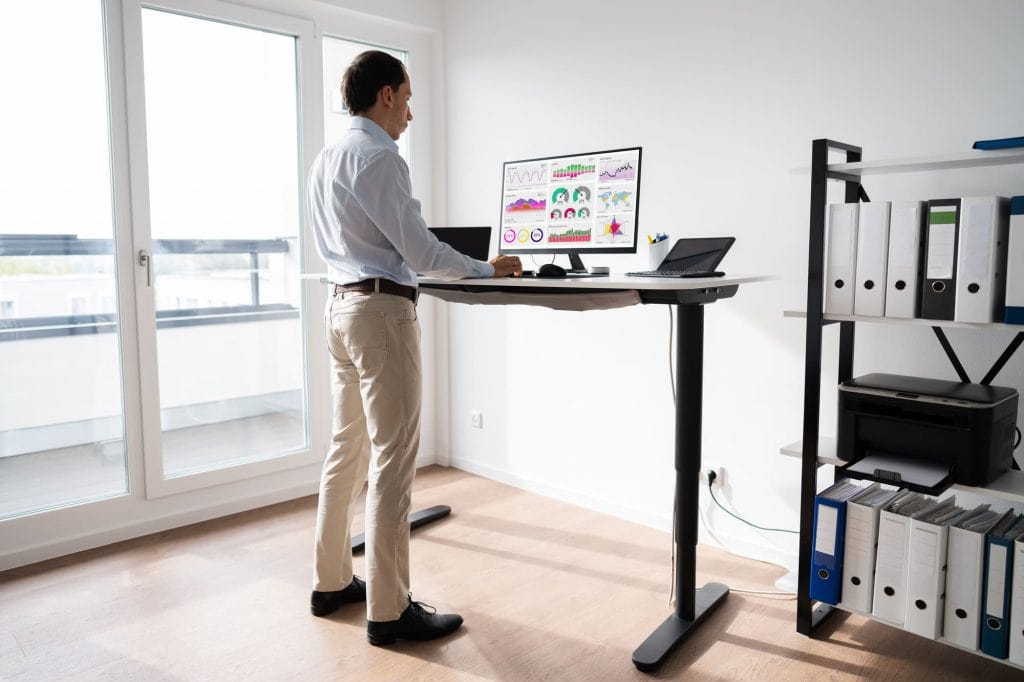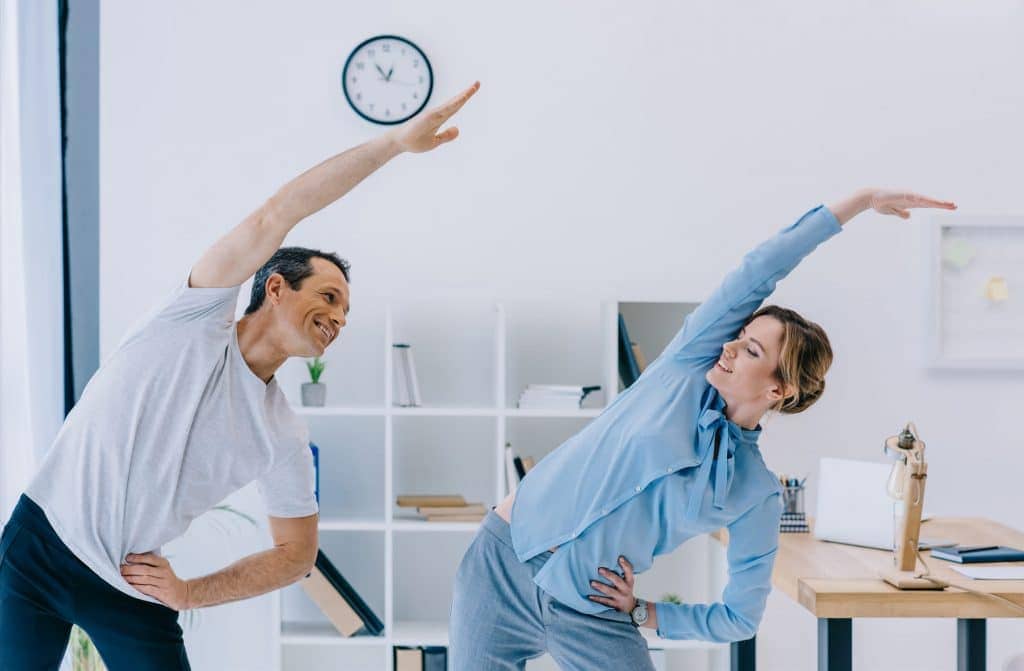*When you buy through links on our site, we may earn an affiliate commission at no additional cost to you.
Standing desks are trending recently and you may have heard the rumors that they have a lot of benefits for your health. But do standing desks help lower back pain as well?
If you’re in pain and you want to find out how to resolve it, (having a standing desk or not) read on, and the answer may surprise you.
Table of Contents
The Root of Back Pain
Some people may claim that standing desks increase the pain levels in their lower back. But it’s probably not the standing desk but their lifestyle.

First of all, if you have chronic back pain you should see a physician and get a proper diagnosis before you speculate what’s wrong.
Nowadays, we know that back pain only rarely has drastic causes and disappears in the vast majority of cases.
Bad Posture
Back pain is the most common issue the modern society has to face, due to the lack of activity and modern lifestyles that don’t require a lot of physical strain anymore (talking about office jobs, sedentary work etc).
The lack of activity and weakened muscle causes a bad posture over time. You lose your flexibility in some places and gain hypertonia in others.
Most back pain-related issues like too much sitting can be prevented by physical activity and fitness, ALL of them can be improved by them if it’s too late already.

The cause of lower back pain from a standing desk is probably caused by a combination of lack of muscle strength and a prolonged period of standing, which is also not optimal.
So the reason is not the standing desk, but your weak back and abdominal muscles that result in an unphysiological posture that creates pressure in your lower back, which starts hurting after a while of standing during your work.
Why Are Standing Desks Trending?
Depending on the study you look at, a standing desk can miraculously cure all the diseases that cease to exist through our modern, activity-poor sedentary lifestyle, sitting all day at your desk job, watching television, and surfing the internet.
But that is not true.
Personally, I love my standing desk, but I also know its benefits and limits.
Standing desks do not cure all malfunctions of your body, bad postures, or diseases, but they do have some benefits that are quite remarkable.
So let’s evaluate what they can and what they can’t do.

What are the health benefits?
- Lowered risk of obesity and weight gain [1]
- Brings down your blood sugar levels [2]
- Decreased risk of being diagnosed with heart problems [3]
- Improved energy levels and mood [4]
- Enhanced productivity [5]
- Reduced caffeine dependency [6]
- Standing adds to your healthy years [7]
and finally…
Standing desks help to reduce overall back and neck pain [8].
Check out our list with the best standing desks and converters for your home office.
But how do they do that?
How A Standing Desk Helps
There are multiple factors that come into place how a standing desk can help with back and neck pain.
If you already have lower back problems it’s very likely you will start to feel discomfort in your neck as well. The pressure in the lower back often times sources from hyperlordosis in the lower spine that results in a forward tilt of the head.
That forward til of the head again will result in pressure in the neck, oftentimes accompanied by headaches.
What Doesn’t Help
Occasionally standing up, pulling your shoulders back, and pressing the chest out won’t help.
At least not longer than just a couple of minutes. The root of the problem are weak muscles that can’t maintain a proper posture.
Also, no one can constantly pay attention to their poor posture. It’s impossible to remain consciously aware of your posture.
What Actually Helps
First of all, using a standing desk can help with weight loss, due to the higher energy expenditure while standing.
Even though not in a striking amount, it can make a difference over time.
Every bit less in weight is a little bit less stress for your spine and discs to carry.
If you develop a bad posture by sitting multiple hours over the day without any counterbalance through physical activity, standing up a couple of times throughout the day is a great option.
If you overdo it and stand for the same amount of hours, it’s considered twice as risky as sitting.
Either way, you need to build up some core muscles to treat lower back pain, no matter at which age!
Switching up positions from sitting to standing can also improve poor posture.

A lot of office workers actually don’t know how to properly adjust their computer workspace ergonomically with the proper desk and chair height.
The result of that is a bad posture, with slouching forward position, leaving the natural s curve of the spine into a c shape.
If you stand up for a couple of minutes you can straighten up and relieve some pressure from the spine.
Depending on your height sometimes even a footrest can be a simple solution to improve your sitting position when your chair is too high.
More Side-Benefits Of A Standing Desk
Also, a stand-up desk will strengthen your leg muscles naturally. If you’re using it in a proper way you won’t stand for prolonged periods of time.
You stand up and sit down multiple times throughout your work.
Thus you activate more muscle tissue frequently, which in combination with standing causes an increase in muscle strength over time.
A health study conducted and published by the Centre for Disease Control found out that regularly using a standing desk can reduce the pain in the upper back and neck area by 54% in just around four weeks [8].
The removal of the standing desk also reversed those effects within merely two weeks again.
Furthermore, the increased activity from standing up and sitting down has an anti-inflammatory effect.
This remarkable effect not only happens in the area of muscle activation but in the nearby areas as well.
Meaning if you train your legs, your lower back will profit from it.
So no wonder standing desks are so popular nowadays.
Generally speaking, reducing sedentary behavior will result in a decrease in lower back pain [9], if that is the cause for it.
Is Standing Or Sitting Better For Lower Back Pain?
Either standing or sitting is better or worse for back pain.
It depends very much on the cause of the back pain, your lifestyle, and how you sit and stand.
Even though a standing desk has some great benefits, standing for multiple hours per day is also bad for you.
You can expect similar negative effects on your body through sitting and standing for more than 4 hours per day.
Sitting may be the new smoking, but standing for the same amount of time is twice as harmful.
Studies show data, that working on your feet all day will also have negative side effects:
- Increase your risk for heart disease
- Cause fatigue
- Muscle pain in the lower limbs
- higher risk for thrombosis or vein diseases
- and other health problems [10]

While another study conducted with 7000 men (between 20-89 yrs) about sedentary behavior shows an increased risk of cardiovascular disease mortality[11].
Men who commute by car even have a 60% higher risk of a heart attack!
So what to do now?
The Solution: Switch it up!
You shouldn’t either stand all day on or sit all day long. None of those is better or worse, you need to switch between those two if you can at work and in your daily activities.
And that’s the biggest advantage of a height-adjustable standing desk or convertible workstation.
It gives you the option to switch your posture and get some more activity.
If you’re sitting all day long at work, try to stand up once per hour for around 10 minutes.
Get some active breaks and stretch a little in between. Take a walk in your break and try to sneak as much activity into your workday as possible.
If you’re doing video conferences you can get a desk treadmill and walk while talking to your colleagues.
Putting Stand-Up Desks Into Perspective – Standing Desk Benefits Debunked?
Let’s take a look at some of the benefits shown in recent studies and see how we can view them relatively.
When people enter a study they have usually a high motivation and a positive attitude towards the trial.
The positive prevailing mood towards the “new thing” is oftentimes enough to brighten up their situation and improve the pain.
They feel accompanied by people with the same issue and get attention from researchers for their suffering.

Thus you can expect a positive outcome like the reduction of issues in the upper back and neck area by a high percentage like in the study mentioned above.
The reduced risk of obesity and weight gain is significant, yet very small.
The amount of weight you can lose by standing up a couple of times every day is neglectable. You can expect way better results by taking a walk for 30 minutes per day.
Another positive effect was an increase in productivity. Yet the study was done with call-center agents who could stand up while they talk to customers on the phone.
If you’re someone who does complicated calculations and needs to be creative or similar tasks that require a lot of focus you may prefer to sit down.
Tips For Using A Standing Desk And Proper Adjustments
If you’re planning to use a standing workplace you should follow these guidelines for the proper adjustments.

- Desk Height: Same as sitting. When you lay down your forearms on the desk top they should be able to rest relaxedly with a 90-degree angle in your elbow
- Monitor: The upper part of the frame should be at your eye level like when you’re sitting as well
- Time: Don’t overdo it and get used to it slowly. You don’t need to stand for a long time, just stand up as long as you start to feel a little fatigue. Then sit down for a while and stand up again after an hour.
- Floor and shoes: Wear something comfortable. If you stand on concrete for a while you can experience ankle or foot pain, even with shoes. Get a balance pad or anti-fatigue mat.
- Vary: As already mentioned multiple times, mix it up. Sitting, standing, talking short walks, do some little stretches, etc. The more activity, the better.
Conclusion: How A Standing Desk Actually Can Help Back Pain
First and foremost you need to get a clear diagnosis of what’s the cause of your lower back pain, it may not be sitting.
If your sedentary lifestyle is actually the cause, the answer is simple: Stand up multiple times for a couple of minutes during your work.
You could start off by elevating your computer with a couple of books to test if standing during your work will help.
Get some active breaks, do some stretches, and hit the gym twice per week.

If you’re standing multiple hours per day, you won’t get any benefits from a standing desk. Try to get some rest, sit down when you can, and also hit the gym to strengthen your muscles for your exhausting job.
Either way, you can ask health experts or a physio to help you with a solution for your lower back pain and get more health information on your distress.


